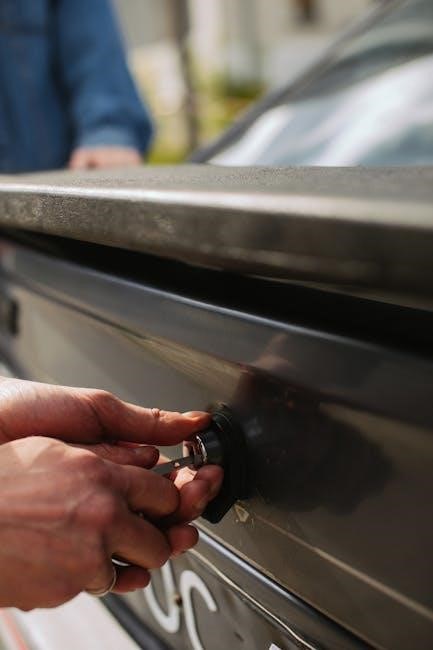hugolog lock manual
Summary
Uh oh! Can’t find your Hugolog lock manual? No worries! Download it instantly here and get back to securing your stuff. Easy peasy!

Hugolog Lock Manual: An Overview
The Hugolog lock manual serves as a crucial guide, providing comprehensive instructions for installation, programming, and operation․ It ensures users can effectively manage access and understand the various features available for their smart lock․

Hugolog Lock Installation
Hugolog lock installation involves several key steps, including mounting the latch and strike plate, aligning the escutcheon, and ensuring the tailpiece is correctly positioned․ Proper installation is vital for optimal lock performance and security․
Latch and Strike Plate Installation
The initial step in Hugolog lock installation involves fitting the latch and strike plate onto the door and frame․ Center the latch within the door’s bore hole, ensuring it aligns smoothly․ Adjustments might be necessary to guarantee a seamless fit, preventing any binding․ Secure the latch using the provided screws, ensuring it is firmly in place․
Next, position the strike plate on the door frame, aligning it with the installed latch․ Trace the outline of the strike plate onto the frame and chisel out the marked area to allow the strike plate to sit flush․ Fasten the strike plate securely with screws, verifying that the deadbolt extends smoothly into the strike plate opening․
This precise installation of the latch and strike plate is essential for the Hugolog lock to function correctly, offering both security and ease of use․ Improper alignment can cause operational issues․
Escutcheon and Tailpiece Alignment
Proper alignment of the escutcheon and tailpiece is crucial for the Hugolog lock’s smooth operation․ Begin by ensuring the tailpiece is correctly oriented before inserting it through the latch mechanism․ The tailpiece should be horizontally aligned when inserting the inside escutcheon, ensuring the thumb turn is vertical․
Carefully attach the outside escutcheon to the door, aligning it with the tailpiece․ Connect the inside escutcheon, ensuring it fits snugly against the door surface․ Secure both escutcheons using the provided screws, tightening them evenly to avoid any warping or misalignment․
Confirm the thumb turn rotates freely, engaging and retracting the latch bolt without obstruction․ If resistance is felt, recheck the tailpiece alignment and escutcheon positioning․ Incorrect alignment can prevent the lock from functioning correctly, compromising security․ Take your time to ensure this step is performed accurately․

Programming the Hugolog Lock
Programming your Hugolog lock involves setting a master code and adding user codes․ Follow the manual’s instructions carefully to secure your home and grant access to trusted individuals efficiently․
Setting the Master Code
Setting the master code is a critical first step in securing your Hugolog lock․ This code serves as the primary means of controlling the lock’s settings and managing user access․ The Hugolog lock manual provides explicit instructions on how to establish a secure master code․ It typically involves entering a specific sequence on the keypad, followed by your chosen code․
Ensure the code is memorable but not easily guessable․ Avoid using obvious sequences like “1234” or your birth year․ A combination of numbers that is meaningful to you but difficult for others to figure out is ideal․
After setting the master code, test it immediately to confirm it works correctly․ This verification step is essential to ensure you can access the lock’s programming functions․
Keep your master code confidential and stored securely․ This code grants administrative control over your Hugolog lock, so it must be protected from unauthorized access․ It’s also advisable to change the master code periodically to maintain optimal security․
Adding User Codes
Adding user codes to your Hugolog lock allows you to grant access to family members, friends, or service providers without sharing your master code․ The Hugolog lock manual details the process for adding these codes, typically involving entering programming mode using the master code․
Each user code should be unique and easy for the individual to remember but difficult for others to guess․ The manual will specify the maximum number of user codes the lock can store․
Once the new user code is entered, test it immediately to ensure it unlocks the door․ It’s good practice to document which user code is assigned to whom for easier management․
You can also delete user codes when they are no longer needed, such as when a guest leaves or a service is discontinued․ Regularly review the list of active user codes to maintain security and control over who has access to your property․ The manual will guide you through the removal process․

Hugolog Lock Operation
Operating your Hugolog lock is straightforward once programmed․ This section covers unlocking and locking from both outside and inside, detailing both manual and automatic modes․ Proper operation ensures security and ease of use․
Unlocking from the Outside
To unlock your Hugolog smart lock from the outside, you have several convenient options․ The primary method involves using your programmed user code․ Simply enter the code on the keypad, followed by the designated unlock button, often indicated by a key symbol․ If the code is correct, the lock will disengage, allowing you to open the door․
Alternatively, some Hugolog models offer key access․ In this case, you can use a physical key to unlock the door, similar to a traditional deadbolt․ Refer to your specific model’s manual for the exact location of the keyhole․
For models with fingerprint recognition, placing your registered fingerprint on the sensor will unlock the door․ Ensure your finger is clean and dry for optimal performance․ After successful fingerprint verification, the lock will automatically unlock․
Finally, if your lock is connected to the Hugolog app, you can unlock it remotely from your smartphone․ Open the app and tap the unlock icon to remotely disengage the lock․
Locking from the Outside
Securing your home with a Hugolog smart lock from the outside is remarkably simple, providing peace of mind with just a touch․ Many models feature a one-touch locking mechanism․ By pressing any key on the keypad for two seconds, the deadbolt will engage, securing your door․ This feature is particularly useful when you’re in a hurry․
Some Hugolog locks also offer an auto-lock feature․ When enabled, the deadbolt will automatically extend, typically 30 seconds after unlocking․ This ensures that your door is always locked, even if you forget to manually lock it․
If you prefer a manual approach, you can also lock the door by rotating the thumb turn on the interior side of the lock․ This provides a tactile confirmation that the door is securely locked․
Lastly, if your lock is connected to the Hugolog app, you can lock it remotely from your smartphone․ This allows you to secure your home from anywhere․
Manual Mode and Auto-Relock Mode
Hugolog smart locks offer both manual and auto-relock modes, providing flexibility in how your door is secured․ In manual mode, the auto-relock function is disabled, and the door can only be locked by pressing any key on the keypad for two seconds from the outside or using the thumb turn on the inside․ This mode is ideal for situations where frequent access is needed․
Auto-relock mode automatically extends the bolt 30 seconds after unlocking․ This ensures the door is always secured, preventing accidental unlocks․ You can toggle between these modes․ Some models let you do so by pressing and holding the multi-function button for 5 seconds․
The choice between manual and auto-relock mode depends on your preferences․ Both modes enhance the security and convenience of your home․

Troubleshooting and Resetting
If you encounter issues with your Hugolog lock, troubleshooting steps and resetting instructions are crucial․ Resetting the lock is often required for proper operation and resolving common problems that may arise during use․
Resetting the Lock
Resetting your Hugolog lock is a crucial step, often required for optimal performance and troubleshooting various issues․ Before initiating the reset, ensure the lock is in the unlocked status and properly powered with fresh AA batteries․ Locate the reset button, typically found on the interior escutcheon․ Use a sharp object, such as a pin or paperclip, to press and hold the reset button․
While holding the reset button, observe the lock for any visual or auditory cues indicating the reset process has begun․ Consult your Hugolog lock manual for the specific reset procedure for your model, as steps may vary slightly․ After resetting, reprogram your master code and user codes to secure your lock․
Remember, resetting the lock will erase all previously programmed codes, restoring it to its factory default settings․ This step is vital when facing operational difficulties or setting up the lock for the first time․ Always refer to the official Hugolog user manual for detailed instructions and model-specific guidance․